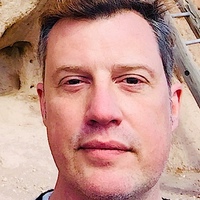Kris Ercums
University of Kansas, Spencer Museum of Art, Department Member
- Contemporary Art, Chinese art history, Japanese Art History, Modern and Contemporary Indian Art, modern and contemporary chinese art, early Chinese art, and 4 moreModern and Contemporary Art History and Theory, Contemporary Asian Art, Art and Globalization, Post-Colonialism, Queer Theory, Queer Studies, and Queer Asian Studiesedit
Research Interests:
This essay explores various symbolic relationships between the human body and landscape in the shanshui tradition of China.
Research Interests:
"Up/Down" was calligraphic installation made of grass that was composed of the Chinese characters: shang and xia, which mean "up" and "down" respectively that the Shanghai-based artist Wang Tiande created at the Spencer Museum of Art in... more
"Up/Down" was calligraphic installation made of grass that was composed of the Chinese characters: shang and xia, which mean "up" and "down" respectively that the Shanghai-based artist Wang Tiande created at the Spencer Museum of Art in 2009.
Research Interests:
In 2010, over the course of several weeks, Seoul-based artist Kim Jongku created a 13-meter, 9-panel steel power painting at the Spencer Museum of Art.
Research Interests:
"Ode to Sprout II" was an installation created by Korean American artist Ke-Sook Lee at the Spencer Museum of Art in 2014
Research Interests:
For his residency project at the Spencer Museum in 2014, Mexico City-based artist Diego Teo examined the complex legacy of the taxidermied horse specimen Comanche in the collection of the KU Natural History Museum.
Research Interests:
In 2012, for his residency project at the Spencer Museum of Art, Chinese artist Chen Shaoxiong created "Prepared," which he conceived as a "technical training camp for demonstrators."
Research Interests:
This essay examines "It Came from the Sky," a whimsical installation by Shanghai-based artist Jin Shan that investigates the dynamics of power and authority and was created as part of a residency project at the Spencer Museum of Art in 2011
Research Interests:
By reframing books as things in Korean chaekgeori painted screen, this essay examines the human-object interaction of books as spatial embodiments of reading and literati achievement.
Research Interests:
This publication details five commission created by Sahej Rahal, Konoike Tomoko, Rohini Devasher, and Park Jaeyoung for the exhibition "Temporal Turn: Art & Speculation in Contemporary Asia" (Spencer Museum of Art, 2017).
Research Interests: Art History, Museum Studies, Contemporary Art, Time Perception, Museology, and 10 moreContemporary Asian art, Contemporary Indian Art, Modern and Contemporary Art History and Theory, Contemporary Asian Art, Art and Globalization, Post-Colonialism, Contemporary Japanese Art, Contemporary Korean Art, Speculative Art Theory, Konoike Tomoko, Sahej Rahal, Rohini Devasher, and Park Jaeyoung
This essay introduces the exhibition "Temporal Turn: Art & Speculation in Contemporary Asia" (Spencer Museum of Art, 2017) and explores contemporary art practice that spans the cultural diversity of Asia and speculates on varied... more
This essay introduces the exhibition "Temporal Turn: Art & Speculation in Contemporary Asia" (Spencer Museum of Art, 2017) and explores contemporary art practice that spans the cultural diversity of Asia and speculates on varied manifestations of time, history, and memory. While many artists in the exhibition approach temporal imagination by adapting scientific methods, others deploy a range of strategies grounded in deep-rooted cultural perspectives. The result is a rich mosaic of concepts that destabilize our conventional understanding of the past, present, and future.
Research Interests:
This paper explores the artistic practice of Korean American artist Ke-Sook Lee through an examination of her artwork "Ode to Sprout II" that was commissioned as part of the exhibition "Holding Pattern: New at the Spencer Museum" in 2014.
Research Interests:
This essay examines three inter-related concepts in the artistic practice of Yeesookyung: ritual, spiritual hybridity, and translation.
Research Interests:
This paper in English and Korean examines three inter-related concepts in the artistic practice of Yeesookyung: ritual, spiritual hybridity, and translation.
Research Interests:
This is the brochure for the exhibition "Extra/Ordinary: Video Art from Asia," which investigated new ways of transforming familiar experiences and daily routines into moments of expanded meaning, contemplation, and humorous reflection.... more
This is the brochure for the exhibition "Extra/Ordinary: Video Art from Asia," which investigated new ways of transforming familiar experiences and daily routines into moments of expanded meaning, contemplation, and humorous reflection. Artist in the exhibition included: Xijing Men, Tsui Kuang Yu, Izumi Taro, Lida Abdul, and Jung Yeondoo
Research Interests:
This paper examines four hanging scrolls of oracle-bone calligraphy created by Chinese archaeologist Dong Zuobin (1895–1963) in the collection of the Smart Museum of Art, University of Chicago.
Research Interests:
Since the founding of the People's Republic of China in 1949, photography as it operated in the public sphere was tightly controlled as a technological apparatus of state propaganda, documenting the official mass "reality" of Chinese... more
Since the founding of the People's Republic of China in 1949, photography as it operated in the public sphere was tightly controlled as a technological apparatus of state propaganda, documenting the official mass "reality" of Chinese socialist society. In 1976, the popular uprising of the April Fifth Movement challenged prevailing paradigms of political power in China that allowed for the advent of unofficial photography that eventually lead to the creation of the April Photographic Society (1979–1981).
Research Interests:
By the mid-eighties, the Chinese art world was in the midst of an exciting paradigmatic shift known as the '85 New Wave movement.
